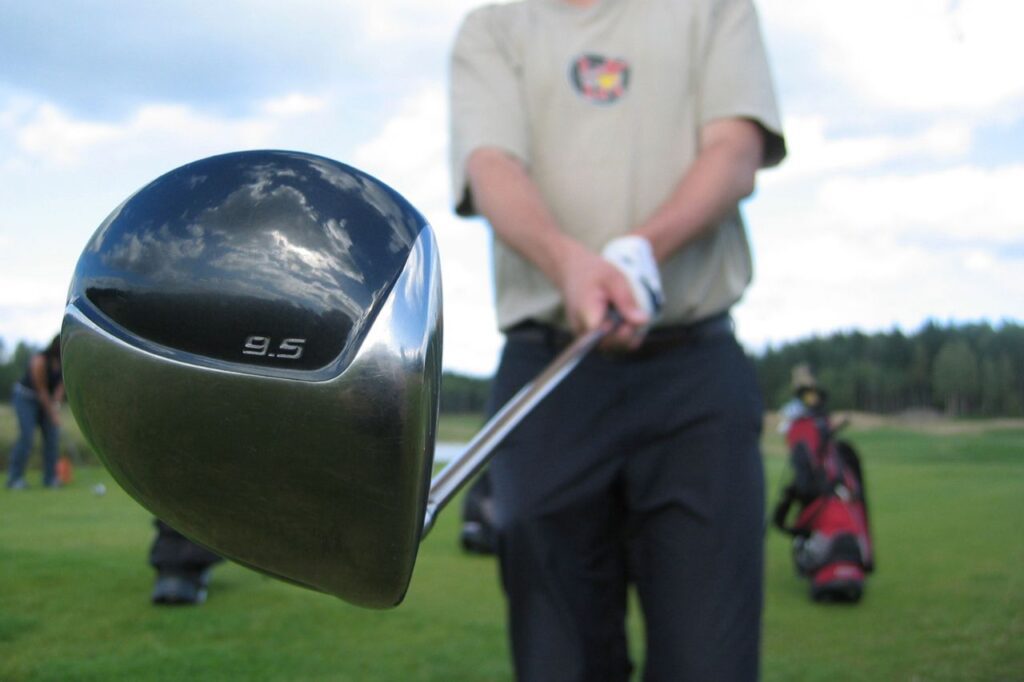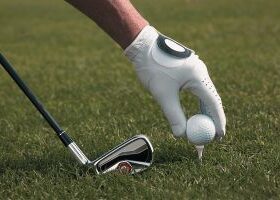

One of the most critical aspects of hitting the ball far and correctly is driver length.
The length of your driver shaft influences your swing, club head, and ball speeds, all of which influence your distance.
Driver length is a personal preference, and what works for one golfer may not work for another.
In this blog post, we’ll review the elements influencing driver length and how to pick the proper length for your swing speed and preferences.
We’ll also go over how to make weight modifications to a driver once it’s been cut down.
What’s the Right Driver Length for You?
On the PGA Tour, the average driver length for men is 45.75 inches. However, driver length varies depending on the golfer’s height and swing speed.
Taller golfers require a longer driver, while shorter golfers require a shorter one.
On the LPGA Tour, the average driver length for women is 44 inches. However, the length of a woman’s driver varies based on her height and swing speed.
A professional fitting is the best approach to establishing the correct driver length for you. A fitter can determine the best driver length for you based on your height, swing speed, and other criteria.
The USGA allows a maximum driver length of 48 inches. Any driver greater than 48 inches is ineligible for tournament use.
The normal driver length for Taylormade is 45.75 inches. However, they offer a choice of driver lengths, so you may select one that is appropriate for your height and swing speed.
How do I Choose Driver Length?
A decent rule of thumb for average driver length is to add 1 inch to your height.
For example, if you are 6 feet tall, you will require a driver that is 6+1=7 inches long. However, this is only a basic guideline, and you should have your driver’s length determined by a specialist.
A professional fitting is the best approach to establishing the correct driver length for you.
A fitter can determine the best driver length for you based on your height, swing speed, and other criteria.
Choosing the right driver length is crucial for your swing. Learn more about golf club lofts and lengths.
What’s the Right Driver Shaft Length for You?
Men’s driver shaft length is 45.25 inches, while women’s shaft length is 44.25 inches.
However, driver shaft length varies depending on the golfer’s height and swing speed.
Longer driver shafts are required for taller players, while shorter driver shafts are required for shorter golfers.
Getting fitted by a professional is the best approach to finding the proper driver shaft weight. A fitter can evaluate your swing speed and other parameters to propose the appropriate driver shaft weight.
Here are some things to think about when selecting the correct driver shaft weight for you:
1. Your swing speed: A heavier driver shaft is required for a faster swing speed, while a lighter one is required for a slower one.
2. Your preference: Some golfers prefer a heavier driver shaft for more control, while others prefer a lighter one for more distance.
How to change a Driver Shaft
- To change the driving shafts, you must first:
- Take the old driver shaft out of the club head.
- Replace the driver shaft in the club head.
- With the driver shaft wrench, tighten the new driver shaft into position.
The driver shaft of a golf club can be changed. It can be accomplished by either a professional or by yourself.
A driver shaft wrench and a new driver shaft are required if you change the shaft yourself.
Driver Length Preferences on the PGA Tour
Individual preferences can contribute to extraordinary performances for PGA Tour Professionals, who have a wide range of driver lengths in their bags.
Most professionals utilize drivers that are 44 to 46 inches long on average.
According to current statistics, most fall between 44.5 and 45.75 inches.
Rickie Fowler, Phil Mickelson, and Bryson DeChambeau are notable exceptions in driver length:
Rickie Fowler: During the 2017 Honda Classic, Fowler utilized a shorter 43.5″ driver. This decision revealed that when used by good players, lower driver lengths can still achieve amazing outcomes.
Phil Mickelson: On the other end of the spectrum, Mickelson won the PGA Championship with a 5.5° driver measuring an astonishing 47.9 inches in his bag. It demonstrates that, while exceptions, some players find success with longer drives.
Bryson DeChambeau: While DeChambeau has had great success with standard-length drivers, he has shown curiosity in testing with a 48″ driver. It demonstrates that players always experiment with equipment tweaks to get the best fit for their game.
Discover how driver length can affect your ability to shape shots, like fades and draws.
The Perfect Driver Length for Your Game
Finding the ideal driver entails attaining the appropriate balance of distance and accuracy.
Long drives of 300 yards or more are remarkable, but only if they are regularly out of bounds.
On the other hand, a driver that hits every fairway but leaves you with difficult 3-wood approaches to par-4 holes may not be optimal.
It is highly recommended that you seek the advice of a qualified club fitter to ensure you have the finest driver for your game.
A professional club fitter will allow you to try different driver heads, shafts, and shaft lengths.
You may then evaluate which combination optimizes your swing, improves your performance, and assists you in achieving the optimal balance of distance and accuracy.
If you want to attempt a different driver shaft length, talk to your club fitter about it at the beginning of your fitting session.
Standard length configurations can be a good starting point because it allows you to fix any issues with your current driver without making major adjustments to the shaft length.
It’s critical to realize that changing the length of a shaft can have a considerable impact on the club’s swing weight the feel and balance of the club during your swing.
When changing the shaft length, a qualified club fitter will consider swing weight modifications to ensure the club remains comfortable and consistent with your swing mechanics.
How to Find the Right Weight for Your Cut-Down Driver
Finding the ideal driver entails attaining the appropriate balance of distance and accuracy.
Long drives of 300 yards or more are remarkable, but only if they are regularly out of bounds.
On the other hand, a driver that hits every fairway but leaves you with difficult 3-wood approaches to par-4 holes may not be optimal.
It is highly recommended that you seek the advice of a qualified club fitter to ensure you have the finest driver for your game.
A professional club fitter will allow you to try different driver heads, shafts, and shaft lengths.
You may then evaluate which combination optimizes your swing, improves your performance, and assists you in achieving the optimal balance of distance and accuracy.
If you want to attempt a different driver shaft length, talk to your club fitter about it at the beginning of your fitting session.
Standard length configurations can be a good starting point because it allows you to fix any issues with your current driver without making major adjustments to the shaft length.
It’s critical to realize that changing the length of a shaft can have a considerable impact on the club’s swing weight the feel and balance of the club during your swing.
When changing the shaft length, a qualified club fitter will consider swing weight modifications to ensure the club remains comfortable and consistent with your swing mechanics.
How to Use the Driver and 2-Wood Together:
The combination of a Driver and a “2-wood” in the bag is becoming more popular, especially among golfers who don’t suffer with distance off the tee.
This configuration allows players to maximize options and adjust their clubs to certain course scenarios.
While distance off the tee is still important, the emphasis switches significantly to favour accuracy and tight shot dispersion with the “2-wood.”
Pushing the driver’s limits is an exciting possibility for golfers using this bag setup.
Experimenting with extreme shaft lengths, lofts, and tee heights can assist in finding the ideal balance of distance and control.
Fast-swinging players with a solid driver swing may experiment with lofts as low as 6° to maximize launch conditions for extra distance.
Teeing the ball higher and swinging up on it more will increase distance potential even further.
Golfers can fully utilize the benefits of the “2-wood” as a “fairway finder” by tolerating a minor reduction in driver accuracy.
The major purpose of the “2-wood” is to lose the least distance when compared to a regular driver configuration while dramatically improving shot dispersion.
This club has a shorter shaft and higher loft, which makes it easier to control and consistently find the fairway.
When contemplating possibilities for the “2-wood,” the following are available:
- Another Driver: Using a conventional driver head with a higher loft and shorter shaft as a “2-wood” allows golfers to fine-tune their club selection for various tee strokes.
- Mini Driver: TaylorMade’s “Original One Mini Driver” has a normal length of 43.75″ and a smaller head (275CC) with adjustable lofts ranging from 9.5° to 13.5°.
These adaptable clubs can be played off the ground, depending on the loft.
- 3-Wood W/ Loft Turned Down: Another appealing choice for golfers looking for a variety off the tee and fairway is a low lofted 3-wood with the loft set down.
Many manufacturers now provide 3-woods with lofts as low as 13°, which may be reduced by another 2°.
Conclusion
Throughout this article, we’ve discussed driver lengths and the importance of finding the right fit for your game.
The ultimate decision, however, rests with you, the golfer, as you embark on the adventure of testing various clubs and choosing what best suits your swing and preferences.








Leave a Reply